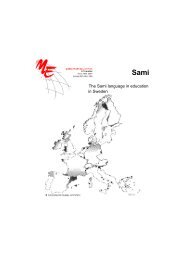Multilingual Early Language Transmission (MELT) - Mercator ...
Multilingual Early Language Transmission (MELT) - Mercator ...
Multilingual Early Language Transmission (MELT) - Mercator ...
Create successful ePaper yourself
Turn your PDF publications into a flip-book with our unique Google optimized e-Paper software.
3.4 Children’s early language development<br />
Babies are not born talking. They acquire language, starting immediately from birth. The<br />
social setting in which children are exposed to their first language is critical; this is where<br />
they hear their language being used. This is the material they must learn to recognize,<br />
analyse, understand, and produce themselves (Clark, 2009). Children’s cognitive<br />
development at least partially depends on their socialising environment (e.g. Bornstein,<br />
2002).<br />
Young children often acquire their language in a natural, playful manner. In Piaget’s view,<br />
children learn to talk naturally when they are ready without any deliberate teaching by<br />
adults. Piaget's theory of cognitive development, which includes development stages, is a<br />
comprehensive theory about the nature and development of human intelligence<br />
(Wardsworth, 1979).<br />
Whether children hear one language or more, start speaking early or late, the language<br />
acquisition of all children occurs gradually through interaction with people and the<br />
environment. Children vary considerably in the speed of their language development. <strong>Early</strong><br />
bloomers in language are not necessarily those who will be the great linguists of the future.<br />
Those children whose language development seems slow early on, may be those who catch<br />
up very quickly later (Baker, 1995). A normally developing child speaks its first words around<br />
its first birthday. Several researchers claim the normal range is 8-15 months. There is no<br />
difference between monolingual and bilingual children. Volterra and Taeschner’s (1978)<br />
hypothesis claims that the initial phase of the developing bilingual child is essentially<br />
monolingual (Volterra and Taeschner, 1978). Psycholinguist Oller (1997) compared the<br />
development of babbling and discovered that bilingual and monolingual children start<br />
babbling at the same time.<br />
Baker (1995) presents the average pattern of development for bilingual children from birth<br />
until 4 years onwards in figure 3.1.<br />
Age<br />
First year<br />
Around 1 year old<br />
During second year<br />
3 to 4 years<br />
4 years onwards<br />
<strong>Language</strong><br />
Babbling, cooing, laughing (dada, mama, gaga)<br />
First understandable words<br />
Two-words combinations, moving slowly to threeand<br />
four- word combinations. Three-element<br />
sentences (e.g. ‘Daddy come now’; ‘That my book’;<br />
‘Teddy gone bye-byes’)<br />
Dramatic changes. Simple but increasingly longer<br />
sentences. Grammar and sentences structuring<br />
starts to develop. Conversations show turn taking<br />
Increasingly complex sentences, structure and<br />
ordered conversation. Use pronouns and auxiliary<br />
verbs.<br />
Figure 3.1 The general average pattern of development for bilingual children (Baker, 1995: 46).<br />
54



